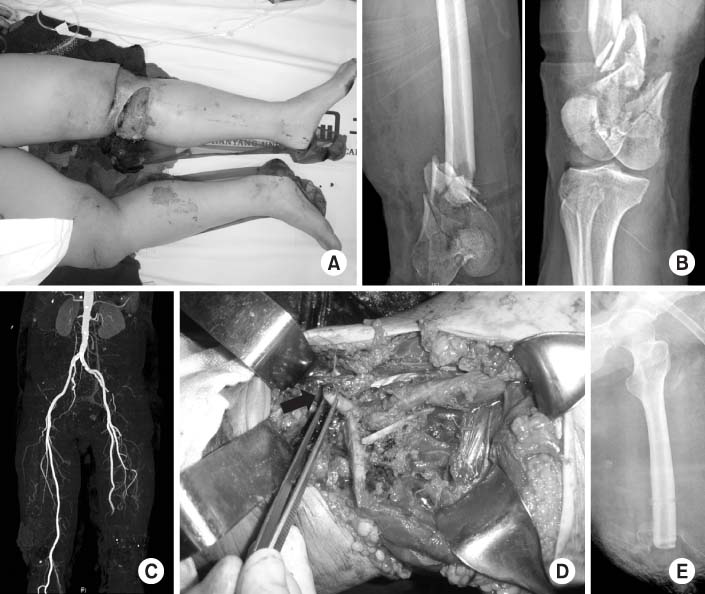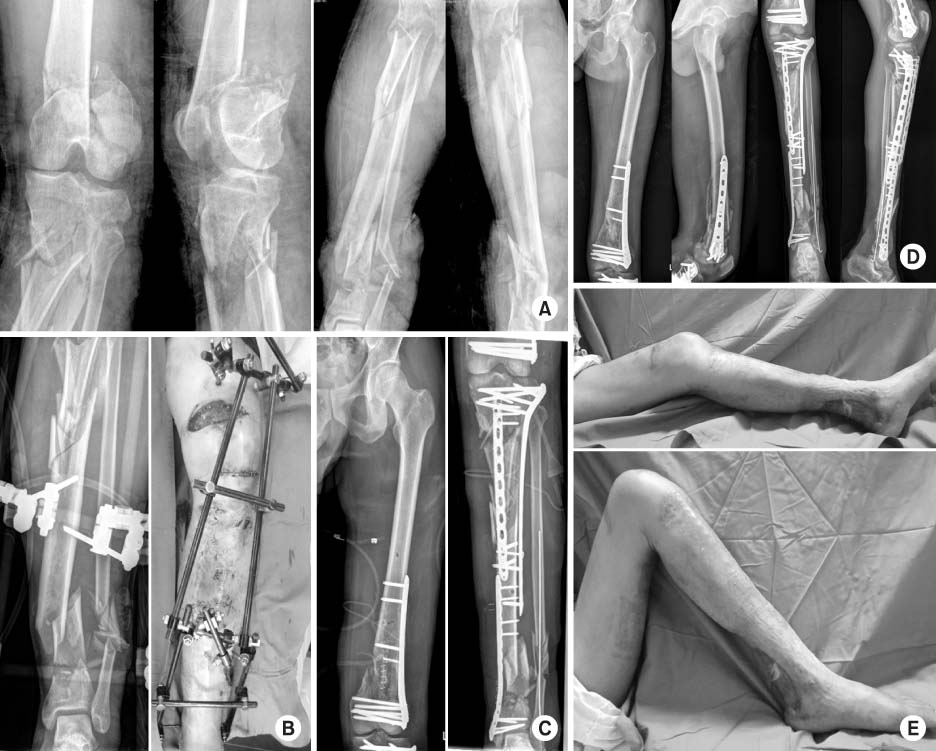Articles
- Page Path
- HOME > J Musculoskelet Trauma > Volume 28(3); 2015 > Article
-
Review Article
- Mangled Extremity: Salvage versus Amputation
- Ki Chul Park, M.D., Hyun Joong Cho, M.D.
-
Journal of the Korean Fracture Society 2015;28(3):198-204.
DOI: https://doi.org/10.12671/jkfs.2015.28.3.198
Published online: July 22, 2015
Department of Orthopaedic Surgery, Guri Hospital, Hanyang University College of Medicine, Guri, Korea.
- Address reprint requests to: Ki Chul Park, M.D. Department of Orthopaedic Surgery, Guri Hospital, Hanyang University College of Medicine, 153 Gyeongchun-ro, Guri 471-701, Korea. Tel: 82-31-560-2318, Fax: 82-31-557-8781, kcpark@hanyang.ac.kr
Copyright © 2015 The Korean Fracture Society. All rights reserved.
This is an Open Access article distributed under the terms of the Creative Commons Attribution Non-Commercial License (http://creativecommons.org/licenses/by-nc/4.0/) which permits unrestricted non-commercial use, distribution, and reproduction in any medium, provided the original work is properly cited.
- 85 Views
- 0 Download
- 1. Gregory RT, Gould RJ, Peclet M, et al. The mangled extremity syndrome (M.E.S.): a severity grading system for multisystem injury of the extremity. J Trauma, 1985;25:1147-1150.
- 2. Kuz JE. The ABJS presidential lecture, June 2004: our orthopaedic heritage: the American Civil War. Clin Orthop Relat Res, 2004;(429):306-315.
- 3. Bondurant FJ, Cotler HB, Buckle R, Miller-Crotchett P, Browner BD. The medical and economic impact of severely injured lower extremities. J Trauma, 1988;28:1270-1273.
- 4. Georgiadis GM, Behrens FF, Joyce MJ, Earle AS, Simmons AL. Open tibial fractures with severe soft-tissue loss. Limb salvage compared with below-the-knee amputation. J Bone Joint Surg Am, 1993;75:1431-1441.
- 5. Francel TJ, Vander Kolk CA, Hoopes JE, Manson PN, Yaremchuk MJ. Microvascular soft-tissue transplantation for reconstruction of acute open tibial fractures: timing of coverage and long-term functional results. Plast Reconstr Surg, 1992;89:478-487.
- 6. Dagum AB, Best AK, Schemitsch EH, Mahoney JL, Mahomed MN, Blight KR. Salvage after severe lower-extremity trauma: are the outcomes worth the means? Plast Reconstr Surg, 1999;103:1212-1220.
- 7. Hertel R, Strebel N, Ganz R. Amputation versus reconstruction in traumatic defects of the leg: outcome and costs. J Orthop Trauma, 1996;10:223-229.
- 8. Bosse MJ, MacKenzie EJ, Kellam JF, et al. An analysis of outcomes of reconstruction or amputation after leg-threatening injuries. N Engl J Med, 2002;347:1924-1931.
- 9. MacKenzie EJ, Bosse MJ, Pollak AN, et al. Long-term persistence of disability following severe lower-limb trauma. Results of a seven-year follow-up. J Bone Joint Surg Am, 2005;87:1801-1809.
- 10. Lange RH, Bach AW, Hansen ST Jr, Johansen KH. Open tibial fractures with associated vascular injuries: prognosis for limb salvage. J Trauma, 1985;25:203-208.
- 11. Howe HR Jr, Poole GV Jr, Hansen KJ, et al. Salvage of lower extremities following combined orthopedic and vascular trauma. A predictive salvage index. Am Surg, 1987;53:205-208.
- 12. Johansen K, Daines M, Howey T, Helfet D, Hansen ST Jr. Objective criteria accurately predict amputation following lower extremity trauma. J Trauma, 1990;30:568-572.
- 13. Russell WL, Sailors DM, Whittle TB, Fisher DF Jr, Burns RP. Limb salvage versus traumatic amputatio. A decision based on a seven-part predictive index. Ann Surg, 1991;213:473-480.
- 14. McNamara MG, Heckman JD, Corley FG. Severe open fractures of the lower extremity: a retrospective evaluation of the Mangled Extremity Severity Score (MESS). J Orthop Trauma, 1994;8:81-87.
- 15. Bonanni F, Rhodes M, Lucke JF. The futility of predictive scoring of mangled lower extremities. J Trauma, 1993;34:99-104.
- 16. Bosse MJ, MacKenzie EJ, Kellam JF, et al. A prospective evaluation of the clinical utility of the lower- extremity injury-severity scores. J Bone Joint Surg Am, 2001;83-A:3-14.
- 17. Suedkamp NP, Barbey N, Veuskens A, et al. The incidence of osteitis in open fractures: an analysis of 948 open fractures (a review of the Hannover experience). J Orthop Trauma, 1993;7:473-482.
- 18. MacKenzie EJ, Jones AS, Bosse MJ, et al. Health-care costs associated with amputation or reconstruction of a limb-threatening injury. J Bone Joint Surg Am, 2007;89:1685-1692.
- 19. Bosse MJ, McCarthy ML, Jones AL, et al. Lower Extremity Assessment Project (LEAP) Study Group. The insensate foot following severe lower extremity trauma: an indication for amputation? J Bone Joint Surg Am, 2005;87:2601-2608.
- 20. MacKenzie EJ, Bosse MJ, Castillo RC, et al. Functional outcomes following trauma-related lower-extremity amputation. J Bone Joint Surg Am, 2004;86-A:1636-1645.
REFERENCES
(A) A 74-year-old woman who suffered diabetes mellitus for 10 years suffered a pedestrian accident. The left leg was pale compared to the contralateral side with a deep laceration wound. (B) X-ray shows a comminution fracture of the distal femur (AO/ASIF 33-C3). (C) Computed tomography angiography shows cut off sign on the left popliteal artery. (D) The patient was transferred to Hanyang University Guri Hospital. The warm ischemic time was over 8 hours after the accident in the operation theater. A arrow indicates the site of the ruptured popliteal artery due to a sharp bony fragment. (E) Above knee amputation was performed due to highly expected morbidity of limb reconstruction.

(A) A 47-year-old man suffered a traffic accident. X-ray shows a comminuted fracture of the distal femur, proximal tibia, and distal tibia. There was no combined neurovascular injury. (B) After debridement an external fixator was applied with vacuum assisted closure dressing. (C) After one week, conversion to internal fixation was performed. The distal femur fracture was managed with open reduction and internal fixation with locking plate. The proximal tibia fracture was managed using the minimally invasive plate osteosynthesis technique. (D) Postoperative 3 months X-ray shows callus formation and good alignment. Clinical photography shows acceptable range of motion of the knee joint with good soft tissue healing.

Mangled Extremity Syndrome Index

Data from the article of Gregory et al. (J Trauma 1985;25: 1147-1150).1)
Figure & Data
REFERENCES
Citations



Fig. 1
Fig. 2
Predictors of Poor Outcome in the Lower Extremity Assessment Project Study
Major Parameters of Each Scoring System
MESS: Mangled extremity severity scoring system, NISSSA: Nerve injury, ischemia, soft tissue injury, skeletal injury, shock, and age, HFS: Hanover fracture scale, PSI: Predictive salvage index, LSI: Limb salvage index.
Mangled Extremity Syndrome Index
Data from the article of Gregory et al. (J Trauma 1985;25: 1147-1150).1)
MESS: Mangled extremity severity scoring system, NISSSA: Nerve injury, ischemia, soft tissue injury, skeletal injury, shock, and age, HFS: Hanover fracture scale, PSI: Predictive salvage index, LSI: Limb salvage index.
Data from the article of Gregory et al. (J Trauma 1985;25: 1147-1150).

 E-submission
E-submission KFS
KFS


 Cite
Cite

